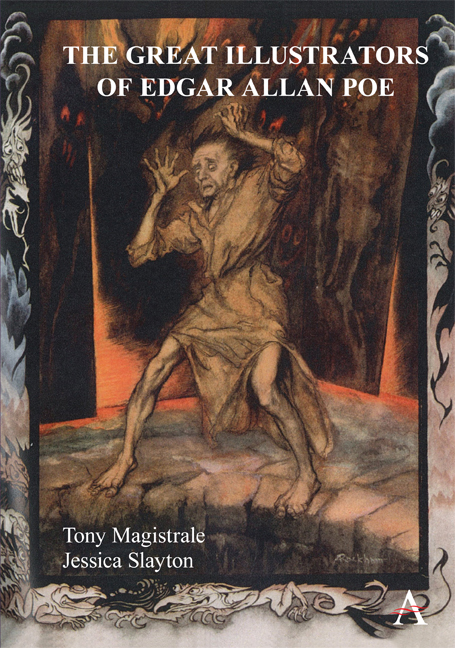3 - Crossing the Fin de Siècle and the English Channel
Published online by Cambridge University Press: 04 June 2021
Summary
Some of Poe's greatest illustrators up to and immediately after World War I— Manet, Doré, Martini, Becher, Blumenschein— successfully carried Poe's works beyond the century of his death, and into the next, a time dominated by the fin-de-siècle anxieties and early Modernist style drawn from the Decadents working a few years prior. We have seen the level to which Manet, Doré, and Dulac romanticized Poe's poetry in accordance with stylistic and literary preferences of the late nineteenth century, while Martini, Becher, and Blumenschein, to varying degrees, worked the short stories through the distorted perspectives of Modernism and German Expressionism. By examining these artists’ works, one may determine that Poe's greatest illustrators typically employ the uniqueness of their medium— non-stand-alone, supplementary visual art made to exist as an inextricable accompaniment to the written text— to simultaneously create their own unique commentaries on the anxieties of their time periods and, at the same time, reconfigure unique emphases in the actual written work, thus highlighting and reshaping its significance. Such is the essence of the parergonal relationship as described by Derrida— artistic work inherently supplementary, changeable, and situated in time holds the power to forever alter the ergon it supplements. In this chapter, we will explore the manner in which Aubrey Beardsley and Harry Clarke carry Poe's work into the British and Irish eye and employ it as an ergon around which to build their own parerga, and how their art serves as yet another avenue for interpreting him in the twentieth century.
As discussed in Chapters 1 and 2, during the fin de siècle, the Decadents began illustrating Poe, taking inspiration from “the horror, mystery, dreams, and explorations of the disordered mind, what Andre Breton would later call, the ‘convulsive beauty’ “ found within the American's work (Vines 12). Poe's visual transition from Romanticism to Decadence was grounded in his place within the Gothic genre and his use of the grotesque. Wolfgang Kayser explains that the grotesque occurs when the supernatural and absurd mix together, creating a caricature that arouses contradictory feelings. That which is grotesque allows the reader or viewer to smile at the same time that she is simultaneously appalled by the deformation of the world as it breaks apart (31)— the appeal to the Decadents here comes in the form of the opposition between contradictory effects.
- Type
- Chapter
- Information
- The Great Illustrators of Edgar Allan Poe , pp. 95 - 126Publisher: Anthem PressPrint publication year: 2021



